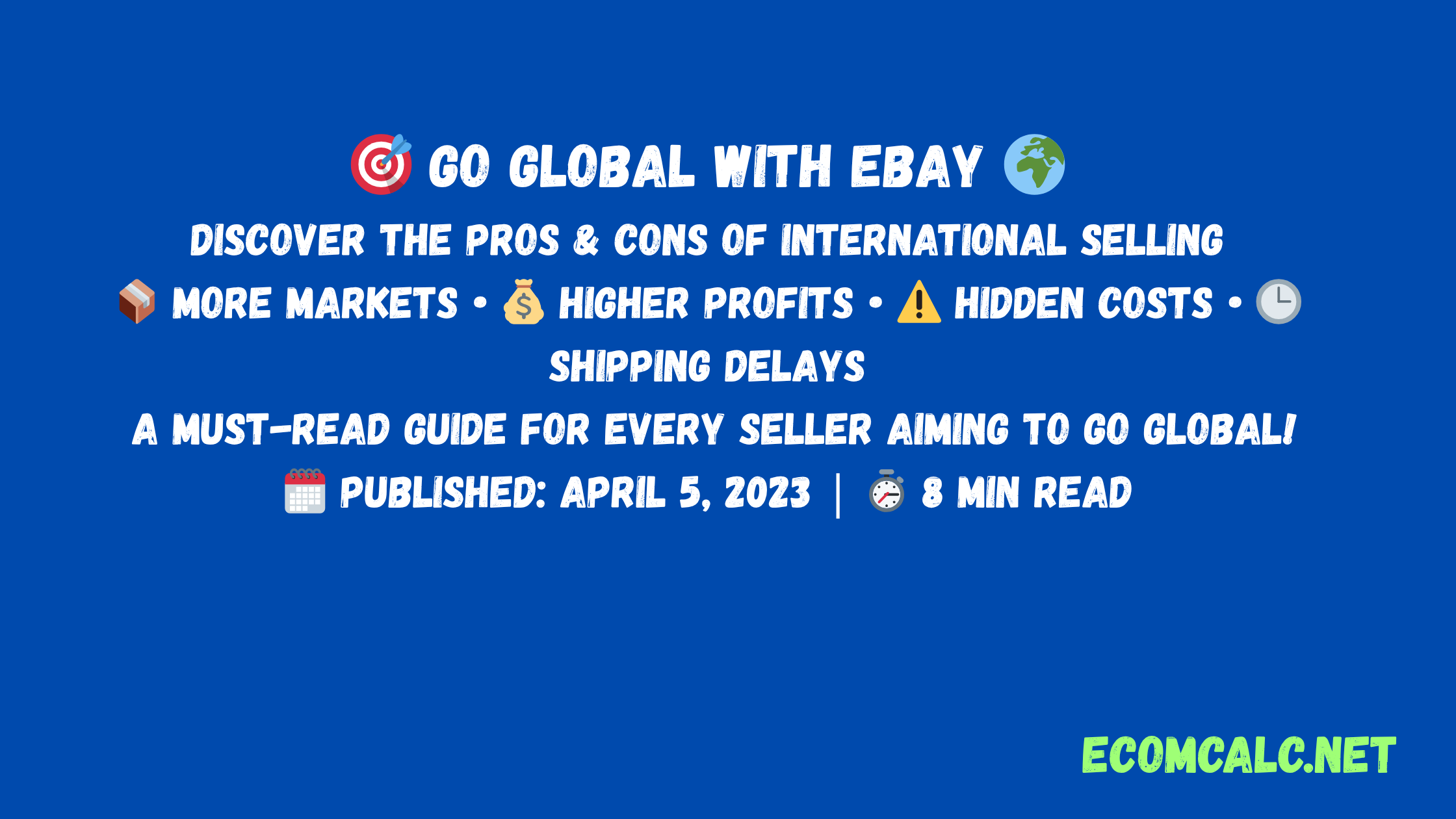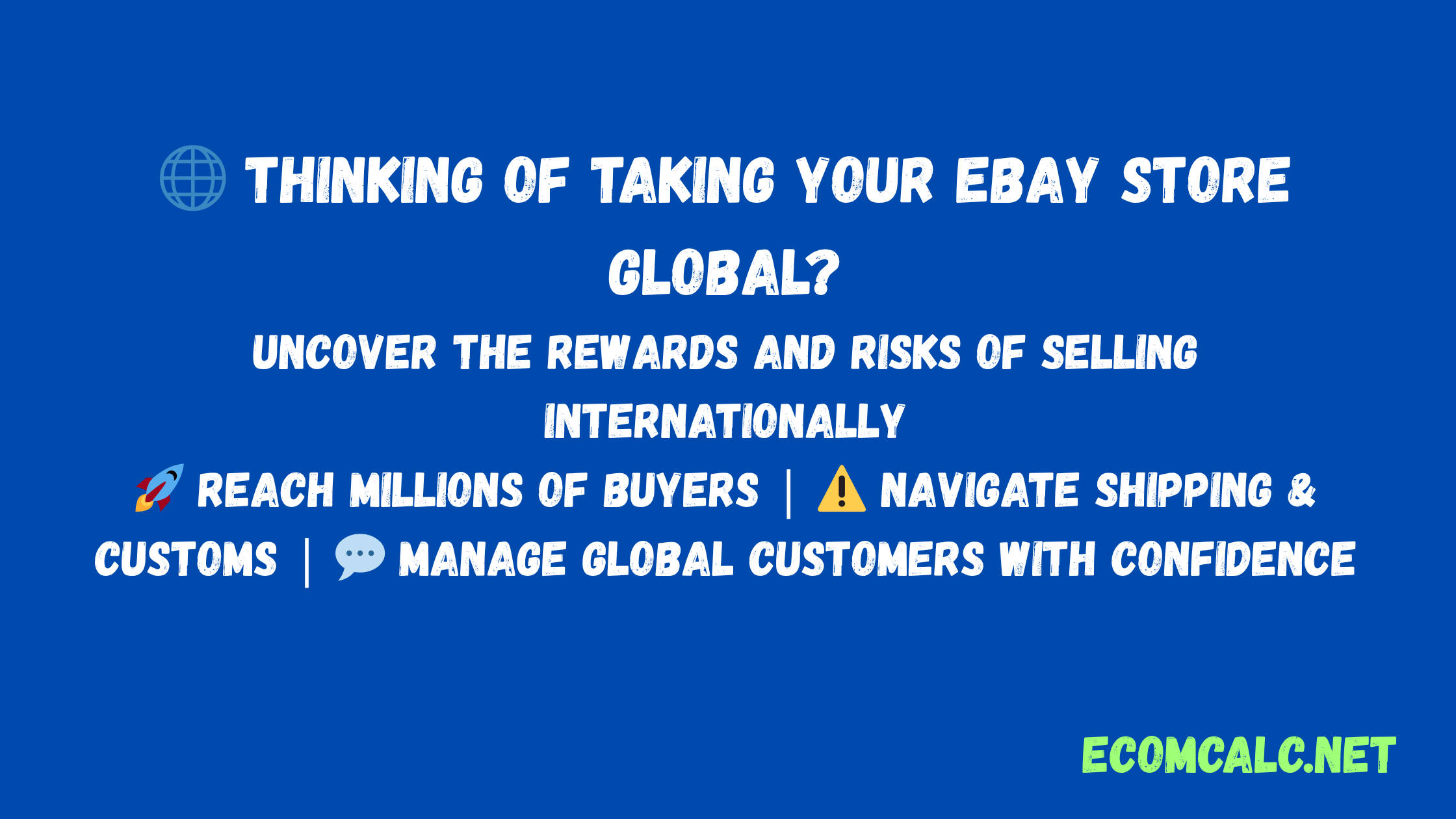eBay International Selling: Pros and Cons
Published on April 5, 2023 | Approximate reading time: 8 minutes
Expanding your eBay business to international markets can open doors to significant growth and brand exposure. But like any major business move, going global brings its own set of advantages and challenges. Whether you're a seasoned seller or just thinking about dipping your toes into cross-border commerce, understanding the pros and cons of eBay international selling is essential to making smart decisions.
In this article, we’ll break down the key factors that affect your success when selling internationally on eBay — from shipping programs to customs, pricing, and customer service. By the end, you’ll be better equipped to decide if this route aligns with your business goals.

Why Sell Internationally on eBay?
Before diving into the pros and cons, let’s understand why international selling is even worth considering.
- Access to Larger Markets: eBay connects sellers to over 190 countries, with millions of active international buyers. Certain products might have limited appeal domestically but see huge demand overseas.
- Diversification: Relying solely on your local market can limit growth. Selling internationally spreads risk by tapping into diverse economies.
- Brand Building: Expanding globally increases brand visibility and credibility, helping you scale faster.
- Higher Profit Potential: Some markets pay premium prices for niche or specialty items, improving your margins.
However, the road to international success is far from simple. Below, we explore the most important pros and cons you need to consider.
1. Global Shipping Program: Simplifying or Complicating?
Pro: eBay’s Global Shipping Program (GSP) is designed to make international selling easier for sellers. Instead of handling complex international shipping logistics yourself, you ship your item to a U.S. shipping center. From there, eBay and its partners take over customs, international postage, and delivery.
This reduces hassle, saves time, and mitigates the risk of customs issues or lost packages.
Con: The convenience comes with a price. GSP charges an additional 15% fee on top of shipping costs, which can cut into your profit margins significantly. Plus, since you’re not controlling the international leg of shipping, you lose some ability to customize packaging or offer different shipping options.
Tips for Sellers:
- Calculate whether the added fees still allow your pricing to remain competitive.
- Use eBay’s international shipping calculator to estimate total costs before listing.
- Consider using GSP only for certain markets or product types where international demand is high.
2. Potential Market Expansion: Untapped Opportunities Abroad
Pro: International buyers can provide huge untapped demand for your products. For example, certain fashion items, electronics, or collectibles may be scarce or expensive in some countries, making your listings highly attractive.
International markets often have buyers willing to pay higher prices, increasing your sales volume and profitability.
Con: Not every product sells equally well globally. Shipping costs, cultural preferences, and competition vary widely. Without proper market research, you might list items that don’t perform well internationally or end up with unsold inventory.
Tips for Sellers:
- Use eBay’s market research tools and third-party analytics to identify products with strong overseas demand.
- Start by testing a few products in select countries before scaling.
- Monitor competitor pricing and buyer reviews to understand local expectations.
3. Customs and Duties: The Hidden Cost Pitfall
Pro: eBay attempts to provide transparency about customs and duties by showing estimated import charges to buyers upfront through the GSP, which can reduce disputes and returns.
Con: Customs and duties remain a major sticking point. Unexpected fees can make your product less competitive or frustrate buyers if they feel they were not adequately informed. Some countries have high import taxes or complex regulations that cause delays or extra costs.
Customs clearance problems can result in lost packages, additional fees, or returns, all impacting your seller ratings and profit margins.
Tips for Sellers:
- Clearly state in your listings who pays customs fees (usually the buyer).
- Research the customs policies of key markets before expanding.
- Factor potential import taxes into your pricing strategy to avoid surprises.
- Use eBay’s Global Shipping Program when possible to streamline customs handling.

4. Customer Service Challenges: Navigating Language and Expectations
Pro: Selling internationally increases your customer base and brand exposure.
Con: It also means dealing with language barriers, time zone differences, and varying consumer behavior. International buyers may have different expectations for shipping times, packaging, return policies, and customer support responsiveness.
Miscommunications can lead to negative feedback or increased support requests. Handling disputes may be more complicated due to cultural nuances or unfamiliarity with foreign payment methods.
Tips for Sellers:
- Use clear, simple language in your listings and communications.
- Prepare FAQs addressing common international buyer questions.
- Consider using translation tools or hiring multilingual support.
- Set realistic shipping expectations and communicate delays promptly.
5. Pricing Strategies: Calculating True Costs for Profitability
Pro: International markets sometimes allow for premium pricing due to scarcity or higher disposable income.
Con: However, you must account for extra costs like international shipping fees, customs duties, currency exchange fluctuations, and eBay’s GSP fees. Overlooking these can turn a seemingly profitable sale into a loss.
Pricing too high risks losing buyers to local competitors or other international sellers. Pricing too low can erode your margins and undervalue your product.
Tips for Sellers:
- Use eBay’s international selling calculator to estimate all fees and costs.
- Monitor exchange rates and update pricing accordingly.
- Consider offering combined shipping discounts for buyers purchasing multiple items.
- Factor in return shipping costs and potential loss from returns or refunds.
Additional Considerations for eBay International Sellers
Shipping Time and Logistics
International shipping generally takes longer than domestic, especially when customs inspections are involved. Long delivery times can deter buyers accustomed to fast shipping options like Amazon Prime.
Using tracked and insured shipping methods reduces risk but adds cost. Sellers should be transparent about expected delivery windows and delays due to customs.
Payment Methods and Currency
eBay supports multiple currencies and payment options, but currency conversion fees can affect your net revenue. PayPal and other payment gateways may also charge additional fees for cross-border transactions.
Set your preferred currency based on your target market, and stay updated on payment platform policies.
Returns and Refunds
Handling returns internationally is more complex and costly. Decide upfront whether you accept international returns and communicate your policy clearly to avoid disputes.
Consider a “no returns” policy on international sales for low-cost items, but balance this with buyer trust.
Real Seller Insights: Success and Challenges
Many eBay sellers have expanded internationally with impressive results. For example, niche sellers in collectibles, electronics, and vintage fashion report increased sales volume and higher average order values from overseas customers.
However, some sellers share stories of frustrated buyers due to customs delays or unexpected fees, and the additional customer service workload caused by international sales.
Summary Table: Pros and Cons of eBay International Selling
| Pros | Cons |
|---|---|
| Access to millions of new buyers | Higher shipping and service fees (15% GSP fee) |
| Opportunities to sell niche products | Customs duties may deter buyers |
| Diversifies revenue streams | Complex customer service and language issues |
| Simplified shipping via Global Shipping Program | Longer shipping times and potential delays |
| Potential for premium pricing | Currency conversion and payment fees |
Final Thoughts: Is International Selling on eBay Right for You?
Selling internationally on eBay can be a game-changer if done thoughtfully. The opportunity to grow beyond your local market and tap into global demand is real—but it requires careful planning.
Before going global, evaluate your product suitability, shipping capabilities, pricing strategy, and customer support readiness. Start small, analyze results, and adjust your approach.
Use eBay’s tools and programs to simplify processes where possible, but always be prepared for the complexities of cross-border trade.

Actionable Steps to Get Started with eBay International Selling
- Research Your Market: Use eBay’s international site traffic data and third-party tools to identify promising countries and product categories.
- Set Up Global Shipping Program: Enroll in GSP for simplified shipping and customs handling.
- Optimize Listings: Write clear, concise, and internationally friendly product descriptions with appropriate keywords.
- Calculate Costs: Use eBay’s calculator to factor all fees, shipping, and duties into your pricing.
- Prepare Customer Service: Set up templates for international buyers and consider multilingual support.
- Test and Learn: Start with a small number of international listings, monitor sales, feedback, and adjust accordingly.
Frequently Asked Questions (FAQs)
- eBay supports selling to most countries worldwide, but you can choose specific countries in your listings.
- GSP charges a fee of approximately 15% on top of shipping costs, which covers customs handling and international postage.
- Usually, the buyer pays customs duties, but it’s important to clearly state this in your listing.
- Return policies vary by seller. Clearly state your return policy for international buyers.
- Provide clear communication, accurate shipping times, transparent fees, and responsive customer support.